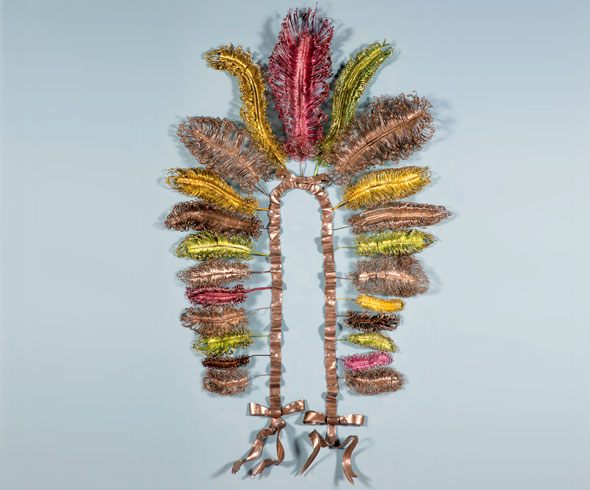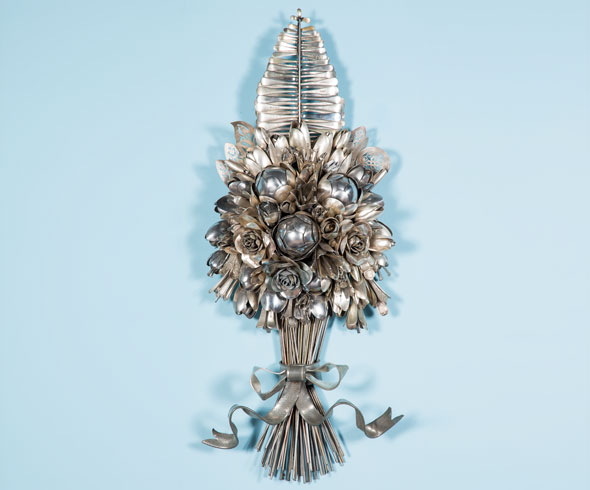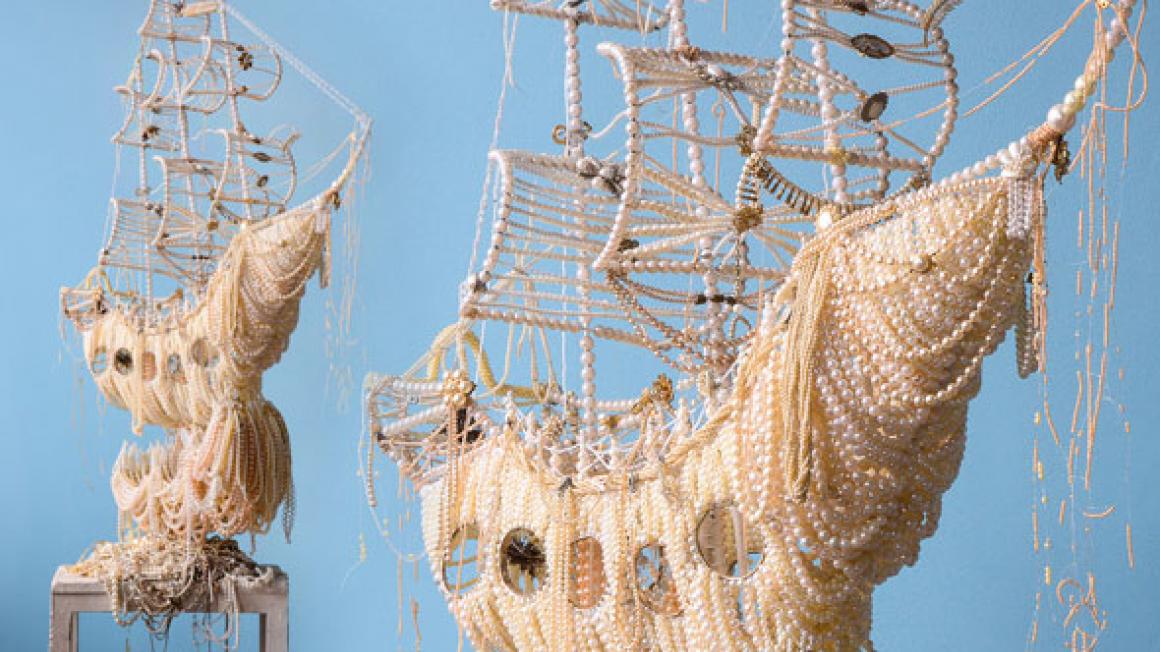Pearly Queen
For someone who watched her handiwork scrutinised one damp June afternoon three years ago by a worldwide audience of 2.5 billion people, she has a very down-to-earth attitude. When she’s in civvies she looks more like the actress Julianne Moore, with a soft Birmingham accent, an infectious laugh and an unaffected capacity to make others feel relaxed.
Ann and her husband left London more than a decade ago in favour of a low-key life for their two sons at the seaside. Her studio is now a vast unheated shed in Margate – hence the all-weather gear. She has no dealer and is never seen at glitzy art parties. I mean it as a compliment when I say she doesn’t really know how to ‘work the room’.
Ann Carrington is an outsider with an insider’s impeccable contacts list. At the Royal College of Art (she was a contemporary of the limelight-loving Tracey Emin), the British designer Paul Smith bought up half her degree show and is staging her current show. Other private collectors include the Duke of Westminster, Sir Elton John and Jacob Rothschild. It was the latter who was indirectly responsible for getting approval from the Palace for her place in history.
 Oversized pewter ‘painting’ of Queen Elizabeth II
Oversized pewter ‘painting’ of Queen Elizabeth II‘I’d made a piece for Jacob Rothschild at Waddesdon Manor to celebrate the Queen’s 80th birthday. He’d asked me to do a portrait of the Queen and he knew I wasn’t going to do it in the traditional sense and so I thought what about if I did a postage stamp? I blew it up large and where the printing dots would have been I put buttons. He’s very close to the Royal Family so I think they may already have seen my work.’
The artwork that adorned the stern of the Spirit Of Chartwell for the Queen’s Diamond Jubilee celebrations in June 2012 was a 10m by 10m red velvet banner with over 500,000 gold buttons, held together by 31 miles of gold thread, hand-sewn by Ann and her three assistants.
Her decision to use buttons, as with all the materials she includes in her work, was a very conscious one. ‘There is a whole history of the river tied up with buttons,’ she says. ‘Because the first Pearly Kings and Queens came about when a costermonger customised his jacket with pearl buttons washed up on the Thames after a Japanese boat sunk. So I had this lovely circular story.’
With the exception of some vintage and solid-gold military ones, these – like all the buttons she uses in her complex artworks – were sourced and dyed exclusively for her by Louis Goldstein in the East End. Some of them are so tiny their circumference is smaller than a sequin. ‘I don’t know how they got the two eyelets in them,’ she says.

She had to seek approval from the College of Arms for the banner. ‘It was like Alice in Wonderland in there with a man who wears white gloves and who runs up and down ladders looking up all the coats of arms going as far back as Cromwell,’ she says of the dusty place that oversees British heraldry.
Approval for the artwork was given on the basis that it was a formal occasion. The banner is a seamless contemporary tribute to a centuries- old tradition. At its core is the coronation crown (St Edward’s Crown) flanked by the lion and the unicorn, with all the coronations from William I onwards threaded around its edge.
The monarchy, or our shared symbols of it, are recurring themes in her work and her new exhibition features intricately worked pewter ‘paintings’ of oversized royal coinage including those of Elizabeth I and Victoria.
‘If you blow something up really big it has a very transformative effect. It looks like embroidery. And pewter is beautiful to work with. It’s etched, slowly, following the same lines as the printer’s tiny marks.’
 Ann taught herself to weld to make the lead ‘feathers’ of the Pom Pom Pompadour headdress
Ann taught herself to weld to make the lead ‘feathers’ of the Pom Pom Pompadour headdressShe taught herself the painstaking process of hammering out the metal before etching the images. ‘Each knock in the metal is where the light catches and that’s what forms the image. You have to be careful with each little nick. You can’t just hammer out a picture of the Queen.’
Her devotion to the Queen’s image is in part due to her fascination with Arnold Machin, the sculptor who designed the iconic profile that has been used on stamps since 1967. Its immediately recognisable simplicity has endured; we are still the only nation in the world not to have the name of our country on our stamps.
At one point Carrington’s recurring desire to pay homage to Machin’s iconic artwork resulted in a call from the men at the Royal Mail. ‘They said it was illegal for me to be using it, as it was designed specifically for them. But quite quickly a solution was found and they gave me a licence to reproduce the image. Now, I’m working with them on designs for small things like mugs that people can buy.’
She is no stranger to art and consumerism. She once made a series of buttons featuring the Queen’s profile for a limited-edition handbag collaboration with designer Lulu Guinness that, in a bizarre twist, the then Camilla Parker Bowles chose to use on her first official date with Prince Charles. ‘I spotted her in the newspapers and thought, oooh, that’s nice, she’s got a picture of her future mother- in-law on her handbag, on her date.’
The floral bouquet sculptures in her exhibition made up of bunches of silver-plated cutlery are deliberate references to the Dutch still life vanitas paintings of the 16th and 17th centuries. Like most sculptors, she is drawn to working with metal, teaching herself how to weld in order to make the lead feathers for the Pom Pom Pompadour headdresses.
The centrepiece of the exhibition is a work called Wing Wo Wave, a Chinese sailing junk made from a tangled weave of pearl necklaces, wedding tiaras, chokers and earrings. It’s named after an industrial estate in China, which manufactures every kind of conceivable pearl adornment in colossal quantities. ‘Pearls are accessible to everyone, even in a pretend way,’ she says. ‘When I made it I was thinking of the discrepancy between pearls as symbols of status and refined taste and those produced in horrible pools. I had collected a tangle of them over decades from boot fairs and second-hand shops. There might be a few real pearls in there but it’s really hard to tell unless you put one between your teeth and do the bite test. If it’s gritty, it’s a real pearl.’
 Viper’s Bugloss, a floral sculpture made of spoons
Viper’s Bugloss, a floral sculpture made of spoonsDespite her resolutely British outlook and output, much of her work is sold to Americans – which is how she came to find herself on a reality TV show by mistake. It’s a long story, she says, but one that involved her and her unwitting husband agreeing to go to New York for a week to complete a commission for a client and then discovering that their every move was being filmed as part of a reality TV show. ‘My husband was not very happy.’
The programme became Bravo TV’s second biggest hit of the year – after Desperate Housewives – and Carrington went ‘viral’ with thousands of emails flooding her inbox. One of the most unusual was from the Chief of Crime for the United Nations, asking her to join a conference on human trafficking. ‘I was subsequently commissioned to make several pieces for the UN about slavery,’ she says.
Still, she admits it was surreal. ‘I was on the plane heading for the first conference with Demi Moore, terrified, just waiting for someone to turn round and whisper, “Oh no, we didn’t mean that Ann Carrington.”’
Pom Pom Pompadour, until 8 April at Paul Smith, 9 Albermarle Street, London W1: 020-7493 4565.


